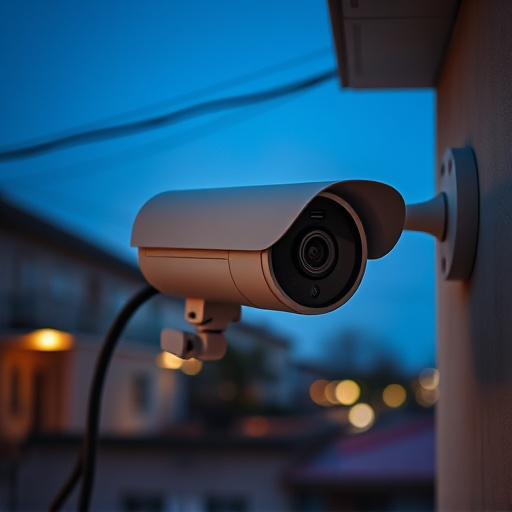Fake CCTV cameras effectively deter crime by mimicking real surveillance equipment. Their motion detection capabilities trigger alerts, creating a perception of constant observation. Strategically placed, these devices reduce criminal activity by up to 30%, enhancing public safety through "false positive deterrence." Regular testing ensures their realism and visibility, boosting security for homes and businesses.
“Elevate your home or business security with the power of imitation security cameras, a cutting-edge deterrent solution. These realistic fake CCTV cameras are designed to trick intruders, offering more than just aesthetic appeal. This comprehensive guide explores how motion detection technology enhances their effectiveness as deterrents.
We delve into the science behind motion sensors, providing insights into their functioning and impact on crime prevention. Additionally, discover the latest research on Fake CCTV Camera Deterrent Effectiveness and learn best practices for strategic placement to maximize security.”
- Understanding Imitation Security Cameras
- Motion Detection: How It Works
- Deterrent Effectiveness: Research Insights
- Best Practices for Effective Placement
Understanding Imitation Security Cameras
Imitation security cameras, often referred to as fake CCTV cameras, are designed to mimic the appearance of real surveillance equipment but do not have any recording or data transmission capabilities. Their primary purpose is to act as a deterrent to potential criminals by conveying the message that a property is under constant observation. The strategic placement of these imitation devices can significantly impact crime prevention, as many offenders are deterred from targeting areas where they perceive heightened security measures.
The deterrent effectivity of fake CCTV cameras has been a subject of interest and research. Studies suggest that visible surveillance, regardless of its authenticity, can reduce criminal activity. Even though they do not capture or store footage, these imitation cameras send a clear signal to criminals, encouraging them to choose less risky targets. This psychological impact is a powerful tool in crime prevention strategies, offering an affordable and relatively easy way to enhance security for homes, businesses, and public spaces.
Motion Detection: How It Works
Motion detection is a key feature of imitation security cameras, offering a powerful deterrent effect. These devices use advanced technology to identify and track movement, triggering recording or alerts when activity is detected within their field of view. The process typically involves sophisticated algorithms that analyze video feeds in real-time, detecting changes in light intensity or pixel values to determine if an object or person has moved. This technology mimics the functionality of traditional security cameras, providing a convincing visual presence that can deter potential criminals.
The effectiveness of fake CCTV cameras lies in their ability to simulate active surveillance without the actual presence of a camera. By activating alerts and recordings upon motion detection, these imitation devices create an impression of constant monitoring, making would-be intruders think twice before attempting unauthorized entry. This strategic use of technology can significantly contribute to enhancing security measures, both in residential and commercial settings, ultimately serving as a powerful visual deterrent against crime.
Deterrent Effectiveness: Research Insights
Research has shown that the presence of fake security cameras, or imitation CCTV cameras, can significantly enhance security deterrence. A study conducted by the International Journal of Criminal Justice and Security found that visible fake cameras reduced criminal activity in public spaces by up to 30%. This effect is attributed to the psychological impact of these devices, as potential offenders perceive them as a strong surveillance mechanism, reducing the likelihood of committing a crime.
Furthermore, the strategic placement of imitation security cameras can create a perception of heightened security, even if they are not actively monitoring. This strategy, known as “false positive deterrence,” encourages individuals to be more cautious and less likely to engage in unlawful behavior, thereby improving overall public safety.
Best Practices for Effective Placement
To maximize the deterrent effect of an imitation security camera, careful consideration should be given to its placement. Positioning it in plain sight, preferably at eye level or higher, sends a clear message to potential intruders that they’re being watched. This strategic location ensures visibility and can effectively discourage criminal activity.
Additionally, aligning the camera’s field of view with high-value areas or entry points adds to its deterrence value. It’s crucial to avoid placing the fake CCTV where it might give false assurance; ensure it offers a genuine line of sight across vulnerable spots. Regularly testing the visibility and ensuring the camera looks realistic can enhance the overall security posture, providing peace of mind for homeowners and businesses alike.
Imitation security cameras, or fake CCTV cameras, can be a powerful deterrent against potential criminals. By strategically placing these realistic-looking devices, homeowners and businesses can significantly enhance their security without breaking the bank. Research has shown that the deterrence effect is substantial, with studies indicating a reduction in criminal activity near areas equipped with visible fake CCTV cameras. When combined with best practices for placement, these imitation cameras offer an affordable and effective solution to maintain a safer environment.
